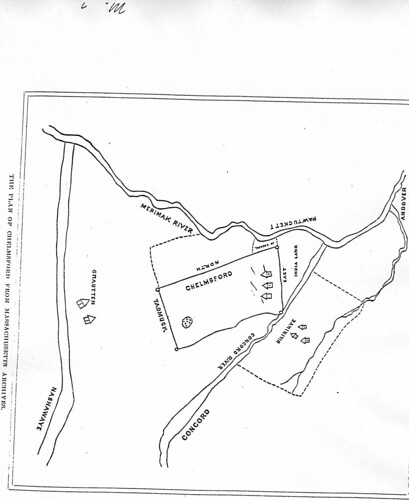President Franklin Pierce: The Lowell Connection

Early map of Chelmsford and Wamesit
President Franklin Pierce: The Lowell Connection
Thanks to Juliet Mofford for her excellent story (posted yesterday) about President Franklin Pierce and the tragic death of his son, Benny. While many probably knew that Pierce was from New Hampshire (the only president from our neighboring state), few may realize that Pierce’s family came from Lowell, or more accurately, from the land that became Lowell.
Let’s start with some Pierce family history:
Franklin Pierce was born on November 23, 1804, in Hillsboro, New Hampshire.
His father, Benjamin Pierce, was born on December 25, 1757, in Chelmsford. At age 18, Benjamin was working on his uncle’s farm, which was located near today’s intersection of Powell, Parker, and Chelmsford streets, when he heard gunfire from the southwest. It was April 19, 1775, and the shooting was coming from Lexington and Concord. Benjamin Pierce grabbed a musket and headed to the sound of the gunfire. Pierce fought at the battles of Bunker Hill, Saratoga, and others. After the Revolutionary War, Benjamin Pierce moved to New Hampshire and ultimately became that state’s governor. He died in 1839 at age 81.
Benjamin Pierce’s father was also named Benjamin. He lived in Chelmsford, however, Benjamin the Elder died when Benjamin the Younger (the Revolutionary War soldier) was only six years old. Benjamin the Younger stayed in Chelmsford and lived with his uncle, Stephen Pierce. It was on the farm of Stephen Pierce that Benjamin the Younger was working on the day the American Revolution began.
Stephen Pierce was born in 1679 in Chelmsford. In 1707, he married Esther Fletcher, also of Chelmsford. Together they had ten children: Robert Pierce, Oliver Pierce, Esther (Pierce) Richardson, William Pierce, Stephen Pierce III, Tabitha (Pierce) French, Experience (Pierce) Parker, Sarah Pierce, Mary (Unknown) Pierce, and Benjamin Pierce.
Stephen played a crucial role in the political organization of this area. In 1725, the residents of Chelmsford elected him to represent them in the Great and General Court in Boston (the “state legislature” before Massachusetts was a state). When Pierce arrived in Boston to take office, the other representatives refused to “seat” him on the grounds that he did not live in Chelmsford and that his election was therefore invalid.
Legally, the legislature’s position was correct. To understand why requires some background of the early English settlement of this region.
The first English settlers came to this vicinity in 1653 when a group of 29 men from Woburn and Concord petitioned the General Court to grant a charter for the town of Chelmsford on six square miles “of upland and meadow” bordering the Merrimack and Concord Rivers. The parcel sought by these settlers (which included what is now downtown Lowell) was already occupied by the Pawtucket Indians who called their settlement Wamesit. Fortunately for the Pawtuckets, a minister named John Eliot had begun visiting them annually in 1647 and had converted the tribe to Christianity.
Because Eliot was committed to the actual as well as to the spiritual well-being of the Pawtuckets, he intervened in the Chelmsford petition and requested the General Court to grant the Indians a charter for the land which they had long occupied and cultivated. The legislature did just that, granting the Pawtuckets 1000 acres on the west bank of the Concord River (downtown Lowell) and 1500 acres on the east bank (Belvidere) for a town to be called Wamesit while also granting the Chelmsford petition albeit for land farther west along the Merrimack (shown on the 1650s sketch map that appears above).
Using modern landmarks, the colonial boundary between Wamesit and Chelmsford ran along Stevens Street in the Highlands neighborhood: everything on the downtown Lowell side was Wamesit; everything on the Drum Hill side of Stevens Street was Chelmsford.
Because of the fall out from King Philip’s War (1675), almost all the Native Americans who lived in Wamesit left for the mountains of New Hampshire. Before they left, they executed a series of deeds transferring ownership of the land within Wamesit to a group of residents of Chelmsford. This group, organized as a trust named The Proprietors of Wamesit Neck, in turn, conveyed smaller parcels to themselves and their neighbors (including Stephen Pierce), however, no one ever addressed the governance of the separate town of Wamesit.
The colonial legislature brought this legal disconnect to the forefront by refusing to seat Pierce. After much protest by the inhabitants of both Wamesit and Chelmsford, the General Court on June 13, 1726, granted a petition by the Town of Chelmsford to annex the land known as Wamesit to Chelmsford. For the next one hundred years, what is now Lowell south of the Merrimack and west of the Concord became East Chelmsford.
Very interesting-love this stuff. Thanks Dick.
Really interesting and instructive. Thanks for posting.